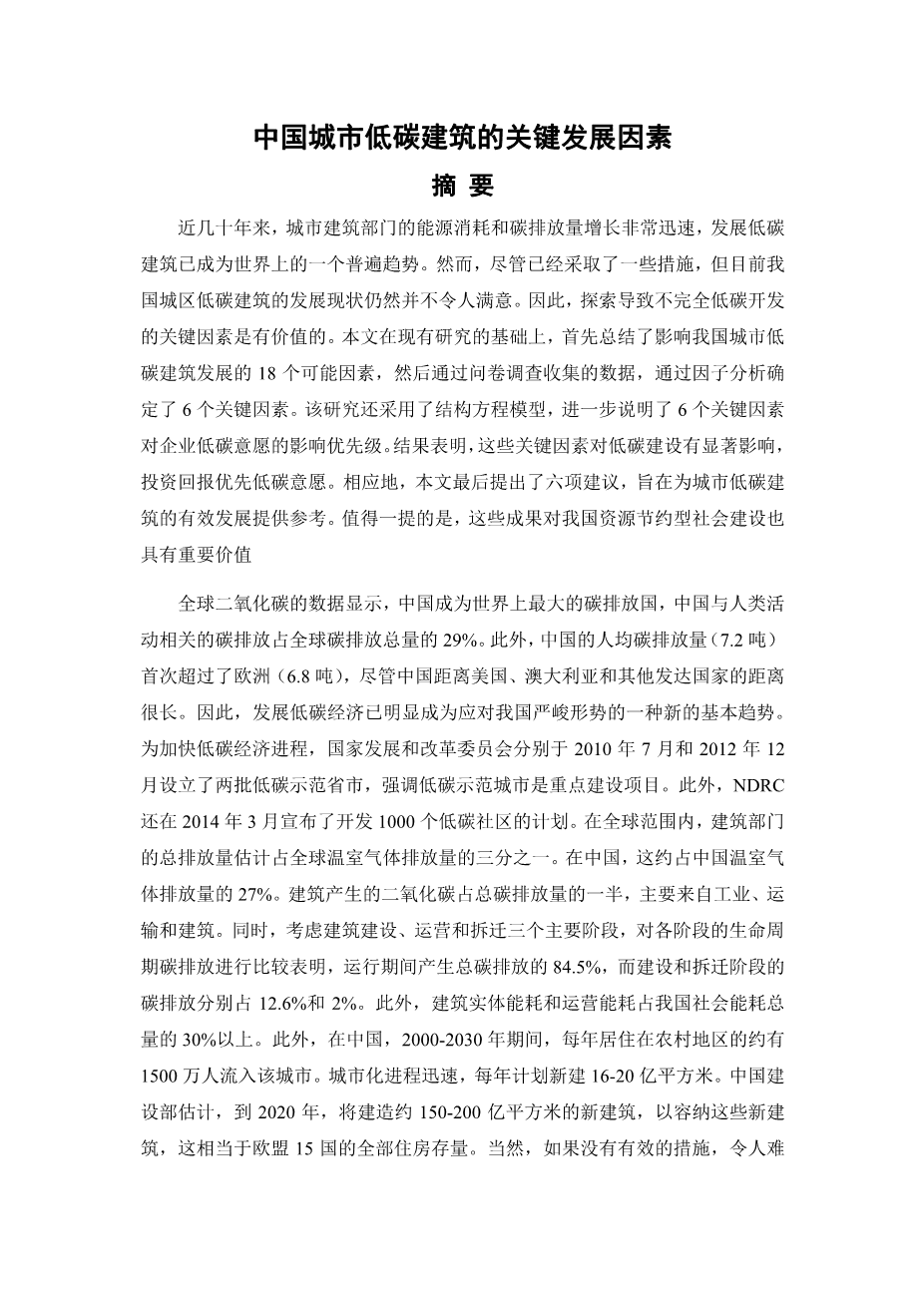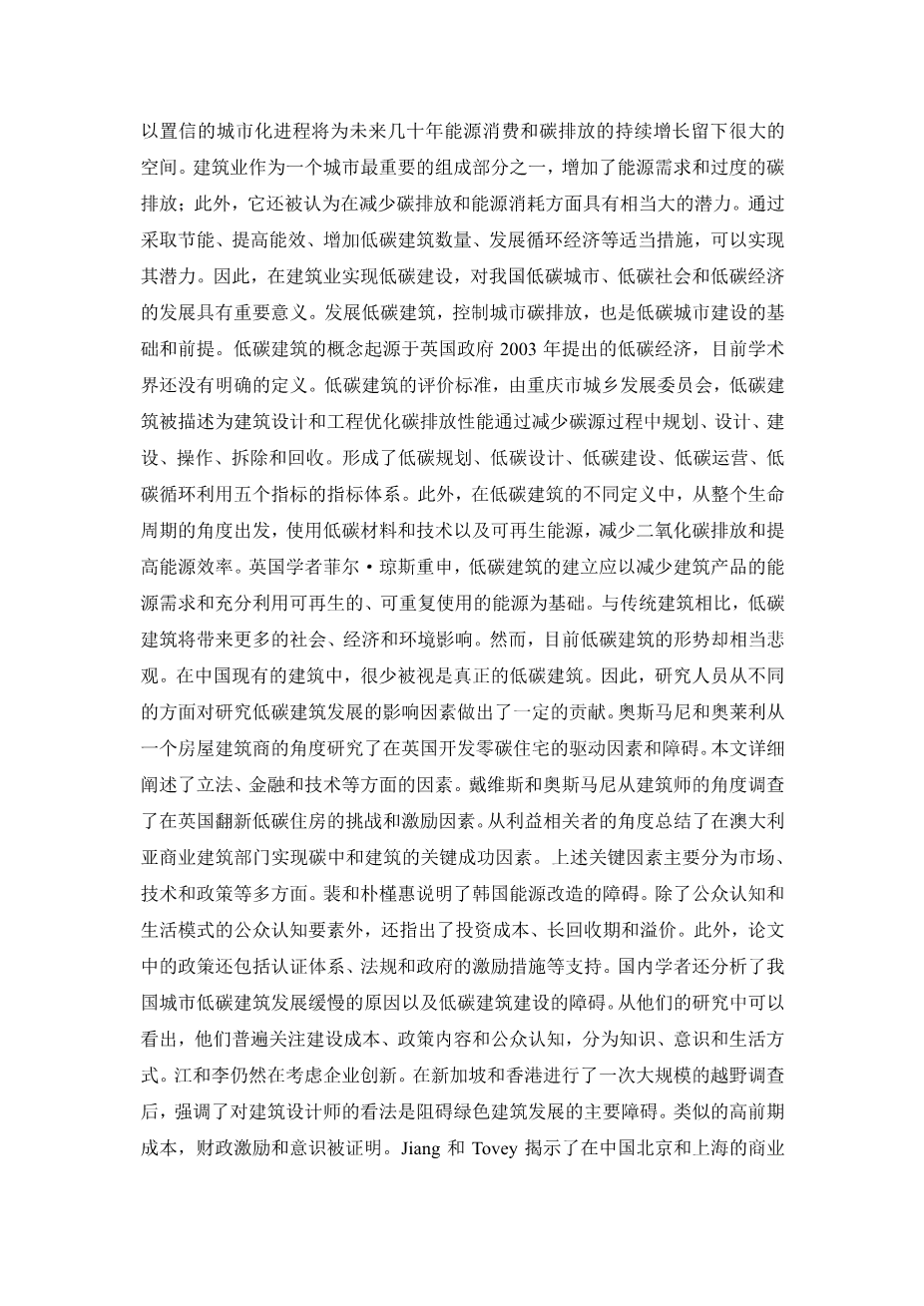中国城市低碳建筑的关键发展因素外文翻译资料
2023-06-29 13:37:19
Critical factors of low-carbon building development in Chinas urban area
Abstract
The energy consumption and carbon emissions of the urban building sector have been growing so rapidly in recent decades that developing low-carbon buildings has become a common trend in the world. However, the current developing situation of low-carbon buildings in Chinas urban area is still dissatisfactory though some measures have been taken. Thus, it is valuable to explore the critical factors responsible for the imperfect low-carbon development. Based on the extant researches, this paper firstly concluded 18 possible factors affecting the development of low-carbon buildings in Chinas urban area Then, with the data collected from a questionnaire survey, 6 critical factors are identified through factor analysis. The research also employed structural equation modeling to further indicate the influence priorities of the 6 critical factors over corporate low-carbon willingness. The results show that all of these critical factors have significant impacts on low-carbon construction and return on investment has the first priority over low-carbon willingness. Correspondingly, six proposals are proposed at the end of the paper with the aim to provide a reference for the effective development of urban low-carbon buildings. It is worthy to mention that the results are also valuable for the construction of resource saving and environmental-friendly society in China
The data in Global Carbon Project reveals that China becomes the largest carbon emitters in the world and Chinas carbon emissions related to human activities account for 29% of the total global carbon emissions. In addition, Chinas per capita carbon emissions (7.2 tons) surpass Europe (6.8 tons) for the first time (Zhao, 2015) though there is a long distance from the US, Australia and other developed countries. Thus, developing low-carbon economy has obviously become a new and essential trend in response to the severe situation in China. To accelerate the process of low-carbon economy, the National Development and Reform Commission (NDRC) established two batches of low-carbon demonstration provinces and cities in July 2010 and in December 2012 respectively and highlighted that the low-carbon exemplar cities are the key construction projects. In addition, the NDRC announced a plan to develop 1000 low-carbon communities in March 2014. Globally, the total emissions from the building sector are estimated to be one-third of the global Greenhouse Gas (GHG) emissions (Levine et al., 2007). In China, those are about 25e27% (Li, 2007) of the countrys GHG emissions. The carbon dioxide generated by buildings accounts for 1/2 of the total carbon emissions which are mainly produced from the industry, transportation and construction (Jiang and Li, 2010). Meanwhile, taking the three major phases of construction, operation and demolition of a building into consideration, a comparison of the life cycle carbon emission for each stage showed that appropriately 84.5% of the total carbon emissions were generated during operation, whereas carbon emissions of construction and demolition phases accounted for 12.6% and 2% respectively (Peng, 2016). Additionally, the embodied and operating energy consumption of buildings accounted for more than 30% of the total social energy consumption in China (Zhu et al., 2014). Moreover, in China, about 15 million people that lived in rural areas before flow into the city yearly during 2000e2030 (UN Department of Economic and Social Affairs (2011)). The rapid process of urbanization leads to 1.6e2.0 billion square meters of new dwellings are planned to build each year (Zhang, 2010). The Chinese Ministry of Construction estimates that around 15e20 billion square meters of new buildings will be constructed by the year 2020 in order to accommodate those newcomers, which are equivalent to the entire housing stock in the EU-15 (Li and Colombier, 2009). Definitely, the incredible urbanization process will leave much room for the incessant growth of energy consumption and carbon emissions in the next decades if there are no effective measures. As one of the most important components of a city, the construction industry has increased energy demand and excessive carbon emissions; besides, it is also considered to have considerable potential to reduce carbon emissions and energy consumption. The potential can be realized by appropriate measures such as saving energy, improving energy efficiency, increasing the number of low-carbon buildings, developing the circular economy, etc. Therefore, achieving low-carbon in the construction industry is meaningful for the development of low-carbon city, low-carbon society and low-carbon economy in China. And developing lowcarbon buildings to control urban carbon emissions is also the basis and premise of the construction of low-carbon city (Xu, 2012). The concept of low-carbon building originated from the lowcarbon economy proposed by the British government in 2003, and there is no clear definition in academia yet. In the Evaluation Standard of Low-carbon Buildings, enacted by Chongqing Municipal Commission of Urban-Rural Development (2012), lowcarbon building was described as a building designed and engineered to optimize carbon emission performance by reducing carbon source and increasing carbon sink in the process of planning, design, construction, operation, demolition and recycling. It also formed an index system including five indicators: low-carbon planning, low-carbon design, low-carbon construction, low-carbon operation and low-carbon recycling. In addition, three common elements among various definitions of low-carbon building can be summarized as follows: reducing CO2 emission and improving energy efficiency, using low-carbon materials and techniques and renewable energy, from a whole life cycle perspective (Sartori and Hestnes, 2007; Williams, 2010; Cao and Liu, 2010; Li and O
剩余内容已隐藏,支付完成后下载完整资料


英语译文共 10 页,剩余内容已隐藏,支付完成后下载完整资料
资料编号:[603074],资料为PDF文档或Word文档,PDF文档可免费转换为Word




